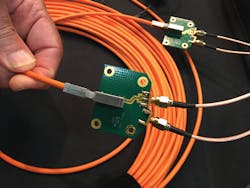As the TIA’s TR-42 committee prepares to meet in October, it moves forward with multiple standards-development projects.
The Telecommunications Industry Association’s (TIA) TR-42 Telecommunications Cabling Systems Committee, which meets as a group three times per year, was scheduled to convene for its final 2018 meeting just as this issue was going to press—the first week of October. In that October meeting, TR-42’s several subcommittees were scheduled to continue work on a number of documents and projects that will provide guidance and specifications for the deployment of cabling systems.
This article will update some of the activities taking place within TR-42 as of the group’s June 2018 meetings.
Several efforts are underway within TR-42, and corresponding standards-development activities are taking place within the Institute of Electrical and Electronics Engineers (IEEE) related to single-pair Ethernet and single-twisted-pair cabling.
Specifying single pair
Three subcommittees of TR-42 are working on four separate standard documents that in some manner address single-pair cabling. Specifically, the TR-42.1 Premises Telecommunications Infrastructure subcommittee is developing TIA-568.0-D-2 and TIA-862-B-2; the TR-42.7 Telecommunications Copper Cabling Systems subcommittee is developing TIA-568.5; and the TR-42.9 Industrial Telecommunications Infrastructure subcommittee is developing TIA-1005-A-4.
TIA-568.0-D-2, the second addendum to 568.0-D, will be titled Single Balanced Twisted-Pair Use Cases and Topology. It will include installation requirements and additional guidelines for transitioning from 4-pair to 1-pair cabling. As of TR-42.1’s June 2018 meeting the document was in a preliminary (draft 0.2) stage of development.
TIA-862-B is the Structured Cabling Infrastructure Standard for Intelligent Building Systems. Its second addendum, 862-B-2, also will add uses cases, topology, and architecture for single-pair cabling. Additionally, it will provide single-twisted-pair cabling guidelines for emerging Internet of Things (IoT) and machine-to-machine (M2M) applications that will require higher density, reduced size, and greater flexibility than can be provided by existing technology. It also is in the early-drafting stage.
This photo, taken at AEM’s booth at the BICSI Fall Exhibition, shows a single-pair cable terminated to a prototype single-pair connector.
TIA-568.5 Single Balanced Twisted-Pair Cabling and Components Standard—not yet at the point of Draft 1.0 as of June 2018—will incorporate specifications including cables, connectors, cords, links and channels. Components and systems compliant to the forthcoming standard will be appropriate for use in non-industrial networks. The standard will be geared toward what are called “MICE1” environments. MICE is an acronym for mechanical, ingress, climatic, and electromagnetic. MICE tables that exist in the TIA-1005-A standard numerically characterize the network environment’s severity for each of the four conditions. The higher the number, the more severe the environment. In practical application, a MICE1 environment is a commercial office space.
In a webcast seminar hosted by Cabling Installation & Maintenance on June 21, Siemon’s global sales engineer, Valerie Maguire, explained that the TIA-568.5 specifications are being developed with the intent of being able to support 10/100/1000Base-T applications. The bandwidth specified is likely to be 100 kHz up to 600 MHz—although that frequency range is not yet finalized. Operation at a frequency as low as 100 kHz may be more significant than it first appears. For other specified cabling systems, including Category 6A, the operating-frequency floor is 1 MHz.
TR-42.7 has developed four channel models in the pre-1.0-Draft stage of development. They are 1 kilometer (using 18-AWG solid or stranded cable with as many as 10 connectors), 100 meters (using 90 meters of 23-AWG solid cable and either 10 meters of 24-AWG cords or 8 meters of 26-AWG cords, and up to 4 connectors), 40 meters (using 30 meters of 22-AWG cable and 10 meters of 22-AWG cords with up to 4 connectors), and 15 meters (using 11 meters of 26-AWG cable and 4 meters of 26-AWG cords with up to 4 connectors).
Completing the TIA-568.5 standard will require TR-42.7 and the overall TR-42 committee to specify a single-pair connector. At the subcommittee’s October 2018 meeting, it is scheduled to select from among multiple proposed single-pair connector variants. The subcommittee’s timeline calls for the standard to be approved in October 2019.
As for TIA-1005-A-4, addendum number 4 to the Telecommunications Infrastructure Standard for Industrial Premises, a first draft is pending. The standard will specify cables, connectors, cords, links, and channels using one-pair connectivity in MICE2 and MICE3environments.
The IEEE is developing the 802.3cg set of specifications for 10GBase-T1. Scheduled for completion in mid-2019, the 802.3cg specs will comprise short- and long-reach versions. 10Base-T1S will specify 10-Mbit/sec links up to at least 15 meters, and 10Base-T1L will specify 10-Mbit/sec links up to 1 kilometer.
In its Standards Informantblog, Siemon states, “A cost-effective, low-speed Ethernet application offers many benefits in support of not only industrial and automotive networks, but also intelligent building networks linking automation, HVAC, security/access, lighting, IoT, and other control and actuator-based devices and systems. Single balanced pair cables can be used in place of a wide range of Fieldbus cables … and single-pair Ethernet can enable interoperability when used in place of RS-232, RS-485, CAN, HART, and other proprietary and custom communication protocols.”
The 10Base-T1L flavor of 802.3cg “will support optional Type E Power over Data Lines (PoDL) remote power provisioning,” the Standards Informant adds. “Four classes of Type E power sourcing equipment will be specified to support up to a minimum of 13.6W over up to 1 km of single balanced pair point-to-point cabling.”
Testing: Some old, some new
Over the summer of 2018, we at Cabling Installation & Maintenance hosted a series of web seminars on TIA standards development and the implementation of existing standards. The June 21 seminar in which Siemon’s Maguire discussed single-pair technologies was part of that series. Another seminar in the series, broadcast live on July 26, included a presentation by VIAVI Solutions’ product line manager Ed Gastle, in which he explained several TIA standards related to fiber testing. Following is some detail from that seminar.
ANSI/TIA-568.3-D Optical Fiber Cabling and Component Standard—The “D” revision includes transmission performance and test requirements in Clause 7. Annex E, which is informative, provides guidelines for field testing. An addendum is being developed.
ANSI/TIA-526-14-C-2015—This document, released in 2015, includes test procedures for installed multimode fiber cable plants. It is an adaption of IEC 61280-4-1 Ed. 2.0 and includes the encircled flux launch condition for 850-nm/50-micron fiber testing.
ANSI/TIA-526-7-A—This standard defines test procedures for installed singlemode fiber cabling plants, and was released in 2015. It is an adoption of IEC 61280-4-2 Ed. 2.0.
Both of the 526 standards are descendants of IEC 61280 standards, but one is an adaption and the other is an adoption. In brief, an adapted standard is reproduced from the original with some modifications. An adopted standard is reproduced without modification. Gastle explained that both TIA and ISO/IEC standards specify two tiers of certification for installed fiber systems. Tier 1 (or basic) incorporates loss, length, and polarity. Tier 2 (or extended) tests are optional additions to Tier 1 tests. Tier 2 testing is carried out using an optical time-domain reflectometer (OTDR), as opposed to Tier 1, for which a power meter and light source, or optical-loss test set, is required.
Tier 1 testing provides a pass/fail result based on loss, length, and polarity. This testing method cannot ensure individual event losses (from splices and connections) are within specification. A Tier 1 test cannot ensure that cable attenuation is uniform. Tier 2 testing adds the characterization of these events to the certification test. Gastle further explained that Tier 2 testing is the ideal fiber troubleshooting tool; it is used to find the cause and location of excess loss, including breaks and reflectance.
Gastle also discussed simplex or duplex fiber testing versus MPO testing. “Existing fiber test standards do not address MPO-specific concerns,” he pointed out. His presentation included the following statement: “Cabling testing standards such as IEC 61280-4-1 for multimode attenuation measurements and IEC 61280-4-2 for singlemode attenuation and optical return loss measurements describe testing simplex or duplex fiber cabling terminated with single-fiber ferrule connectors. These IEC standards are difficult to apply to the testing of installed multi-fiber cabling terminated with multi-fiber connectors (MPO).”
The ISO/IEC’s Subcommittee 86C, Working Group 1 (SC 86C WG 1) released a technical report on testing MPO cabling in 2017. The document, IEC TR 61282-15:2017, “provides guidance for the testing of multi-fiber cable, multimode or singlemode, terminated with [MPO plugs],” the document’s abstract explains. “Guidance is provided on the measurement of attenuation, polarity, length and optical return loss.”
Gastle explained that the TIA’s TR-42.11 Optical Fiber Systems Subcommittee is working on an addendum to TIA-568.3-D. A current proposal within the group is for that addendum to reference the IEC technical report. Additionally, the IEC SC86C WG1 is working on an MPO-specific testing standard, which currently is in draft.
VIAVI’s Gastle also pointed to a practical reality for network and cabling managers, as well as technicians who work in data centers. In these facilities, many high-speed connections are made via active optical cables (AOC) or direct-attach copper (DAC) cabling. These fixed-length cables are terminated to QSFPx or to SFPx transceivers. In these applications, testing can be challenging.
“There is no test access to the actual fiber or copper cabling,” Gastle explained, because the media terminates directly to the transceiver. “Traditional media tests cannot be used to certify the cable,” he added. Technicians need a tester than can accept dual SFP/QSFPtransceivers.
The primary parameter of an AOC/DAC cable is bit error rate (BER). BER testing can be accomplished using a stress pattern, such as PRBS 31 (Pseudo-Random Binary Sequence 31), Gastle explained. Pass/fail criteria can be determined by comparing PRBS 31 results to a cable BERspecification.
To employ this test method, before the AOC/DAC is installed, the technician uses a single unit containing 2 ports; each end of the cable is inserted into one of the ports and the cable is evaluated before being installed. After the AOC/DAC is installed, the technician needs two test units, to access each end of the cable. Each end is connected to a test unit, a cable test script is run on the first unit, then monitor/through-mode (loopback) is run on the second unit.
Prescribing polarity
At its June 2018 meeting, TR-42 accepted a project authorization request (PAR) to initiate work on a document that will become a telecommunications systems bulletin (TSB) related to polarity in fiber-optic cabling systems. The PAR explains, “This TSB provides guidance to polarity with respect to optical components defined in ANSI/TIA-568, e.g. duplex fiber-optic connectors and single-row and double-row multi-fiber-optic array connectors, therefore giving readers clarity to their interactions and channelconnectivity.”
The PAR further explained that a TSB related to fiber polarity will complement TIA-568.0-D Generic Telecommunications Cabling for Customer Premises, and that standard’s addenda, and also will complement TIA-568.3-D Optical Fiber Cabling and Components Standard, and its addenda.
The TSB will be developed within the TR-42.11 Optical Systemssubcommittee.
We at Cabling Installation & Maintenance track the development of standards within the TIA and other standards-making bodies. Continue to follow us here and online for details on cabling and networking standards activities.

